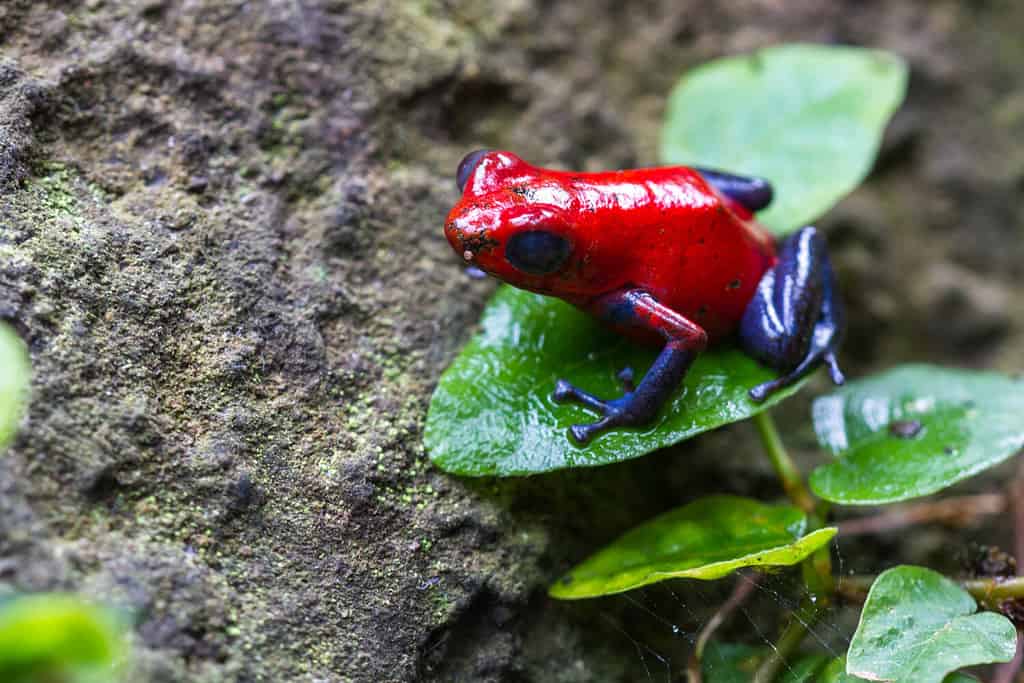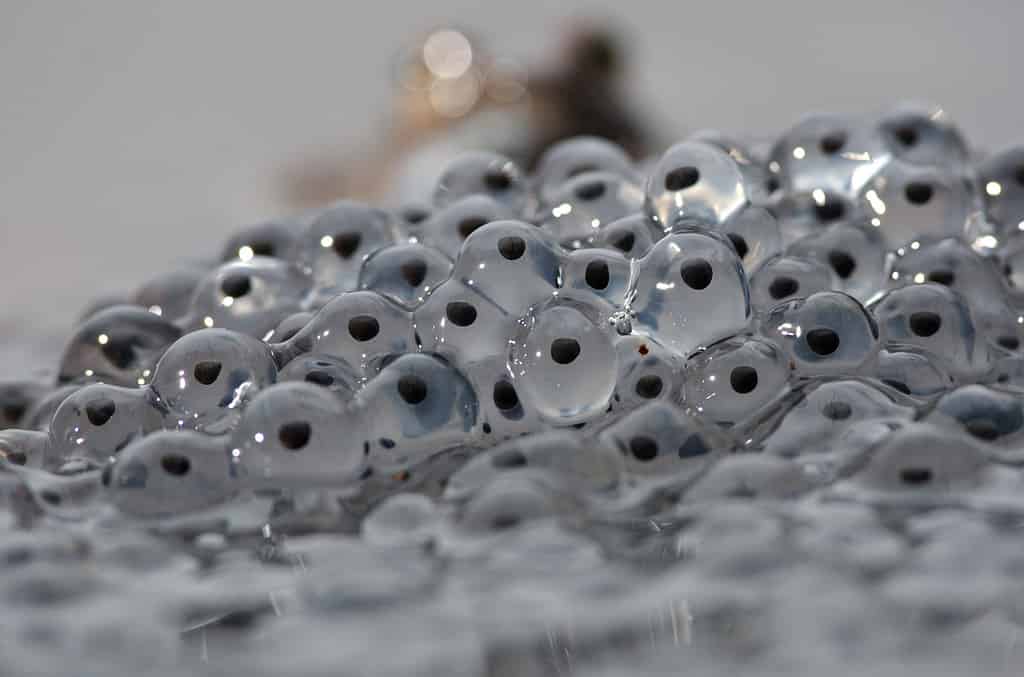Toads and frogs usually start breeding in late winter or early spring if the weather is agreeable. Also, they will begin mating when there is a change from dry to wet seasons. Therefore, the breeding season will end in summer to give the offspring the longest time to mature before the dry season and winter approaches again. Usually, frog reproduction takes place in water through external fertilization. Therefore, male frogs will reside in bodies of water and call for female mates at night.
Some frogs will breed in temporary pools/ vernal ponds. These are temporary ponds created by spring rain and melting snow because no fish can prey on their offspring. However, many frogs will look for more permanent bodies of water because their tadpoles will not undergo metamorphosis until the following winter. If they choose this, the female will enter the male’s territory, and the male will jump on her back. When frogs do this, it is called amplexus.
How Do Frogs Mate?
Frogs start mating when the male calls for the female by croaking. Then when the male finds a suitable female, he will attach himself to the female’s back in a position called amplexus. After that, the female will release eggs into the water, which the male will fertilize externally. Frogs occur from high mountainous regions to sea level. However, they are so well camouflaged that they are not easy to spot when they sit among vegetation. Therefore, they are usually only spotted when they croak or leap.

Frogs start mating when the male calls for the female by croaking. Then when the male finds a suitable female, he will attach himself to the female’s back in a position called amplexus.
©zdenek_macat/Shutterstock.com
Color
North America boasts many different frog species with several shades that distinguish them from one another. Some species are olive-brown, while others are bright yellow, and you also find some greenish-gray species. In addition, they have different markings, and some have speckles or marbling. Furthermore, most frogs have streaks around their eyes and dark crossbars on their limbs. These crossbars help camouflage them when the frog tries to merge into its surroundings.
Frogs have another clever way of camouflaging by changing color. They do this by moving the pigment cells around their bodies, contracting or spreading them, thus darkening or lighting the skin. This is also an excellent way of making them more attractive to a mate. However, even though their color can change, their patterns or markings remain the same. Also, environmental conditions influence a frog’s color. In warmer conditions, they will usually turn a lighter color; in cold, damp conditions, they will generally be darker.
A frog’s skin is typically smooth but has small bumps on the flanks. However, a female frog’s skin will become rougher during the spawning season. The reason for this is to help the male distinguish sex during this period. Also, frogs have mucous glands in their skin. These glands keep them moist, which allows the frogs to breathe through their skin.
Additionally, their skin absorbs moisture, so the frog doesn’t have to drink water. Frogs will shed their skin as they grow. Once the mucous glands sufficiently lubricate the fresh skin underneath, the transparent top layer of dead skin will fall off.

North America boasts many different frog species with several shades that distinguish them from one another. Some species are olive-brown, while others are bright yellow, and you also find some greenish-gray species.
©Nature’s Charm/Shutterstock.com
Frog Breeding Cycle
During February or March, frogs start emerging from their winter homes, including ditches and ponds. Therefore, sightings only occur this time of the year. Frogs will then begin to assemble at different breeding spots, such as flowing canals and water ponds, where reproduction occurs. Also, many frogs will travel up to half a mile or more to reach a specific breeding spot.
Sometimes, they can be spotted together on rainy nights. Firstly, males will arrive at these spots and start croaking to lure females. The males will croak at different pitches and tempos all through the night if necessary. Frogs make these sounds by closing their nostrils and mouths and moving air forward and backward over their vocal cords. In addition, this sound can be amplified by moving more air in and using their vocal sacs to push out their throat pouch. Males can be very noisy at times. However, female frogs are typically quieter and may occasionally make the odd grunt. All these sounds will eventually lead to frog reproduction.
Amplexus
Frogs, unlike many mammals and birds, do not go through unique and elaborate mating rituals with preening or prancing. Instead, frog reproduction is simple, and the male will grab the closest female as soon as she arrives at the breeding spot. He will then jump on her back and wrap his forelimbs around her body. Next, he will hold the nuptial pads in position, known as amplexus. After that, the male fertilizes the eggs released into the water by the female externally.
Female frogs can release over 2000 eggs at a time. While the male fertilizes the eggs, the female presses her forelimbs against her abdomen. Also, amplexus can take a few seconds or even up to a month. This process usually takes place on the water. The eggs the female releases are fertilized as soon as they are laid and before they can absorb water. These eggs are tiny and held in a gelatinous capsule that swells up to three times its size.
Furthermore, these eggs will fall to the bottom of the water. Later, they will start floating again and join the rest of the spawn. Frog eggs then start developing into tadpoles, which is the next stage and can take 10 – 21 days, depending on the temperature and location. These tadpoles will survive by using the jelly around them. They do this by ingesting it using a special gland. In addition, at this stage, they do not have mouths and therefore get nourishment from the egg yolk. Later, they start to eat plants and breathe through three pairs of gills. These gills are external. However, a flap of skin covers them. Then, after seven weeks, their hindlegs will have formed, and a week later, their lungs develop. By May or June, the frog will be fully formed.
Survival of Eggs
Female frogs can lay more than 2,000 eggs at a time. However, many will not survive for long. There are a variety of predators that will feed on them, such as:
- Ducks
- Gulls
- Snakes
- Badgers
- Shrews
- Herons
As well as these predators, pollution can also cause damage to masses of frogspawn, and another danger is insecticides used by farmers. Also, the river’s dredging is a problem, leading to fewer ponds.

Female frogs can lay more than 2,000 eggs at a time. However, many will not survive for long. There are a variety of predators that will feed on them.
©Marco Maggesi/Shutterstock.com
Spawn
The meaning of spawn is the release of eggs. When the spawn are freshly laid, they are dark, like caviar. However, as soon as it takes on water, it changes into the familiar clear jelly with black centers. If the spawn is healthy, it will take between 8 to 10 days to hatch. Sometimes, when it is very cold, frost may kill spawn at or under the water’s surface, resulting in the eggs turning white. This is more of a risk in shallow water. Unlike toads, frogs can breed in colder temperatures, and they hibernate close to their breeding sites. Frog reproduction is one of the earliest and most eagerly awaited signs that spring is coming.
The photo featured at the top of this post is © Daniel Prudek/Shutterstock.com
Thank you for reading! Have some feedback for us? Contact the AZ Animals editorial team.







